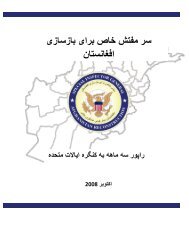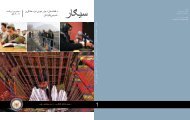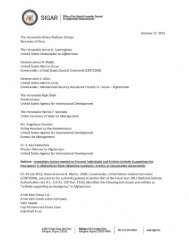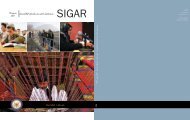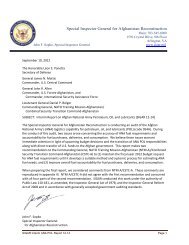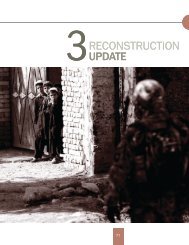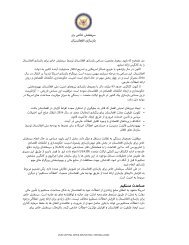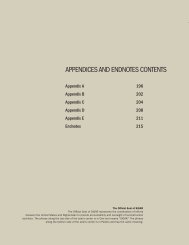Afghanistan's Control and Audit Office Requires Operational and ...
Afghanistan's Control and Audit Office Requires Operational and ...
Afghanistan's Control and Audit Office Requires Operational and ...
You also want an ePaper? Increase the reach of your titles
YUMPU automatically turns print PDFs into web optimized ePapers that Google loves.
OFFICE OF THE SPECIAL INSPECTOR GENERAL FOR AFGHANISTAN RECONSTRUCTIONApril 9, 2010The Honorable Hillary R. ClintonU.S. Secretary of StateThe Honorable Karl W. EikenberryU.S. Ambassador to AfghanistanDr. Rajiv ShahAdministrator U.S. Agency for International DevelopmentWilliam M. FrejUSAID Mission Director to AfghanistanThis report discusses the results of the <strong>Office</strong> of the Special Inspector General for AfghanistanReconstruction’s review of U.S. <strong>and</strong> other donor efforts to strengthen the capability of Afghanistan’s<strong>Control</strong> <strong>and</strong> <strong>Audit</strong> <strong>Office</strong> (CAO) to deter <strong>and</strong> prevent corruption. It includes two recommendations tostrengthen the CAO’s capability <strong>and</strong> capacity. This report is part of a series of audits of U.S. efforts tocombat corruption <strong>and</strong> strengthen the rule of law in Afghanistan.A summary of this report is on page ii. This performance audit was conducted by the <strong>Office</strong> of theSpecial Inspector General for Afghanistan Reconstruction under the authority of Public Law No. 110-181<strong>and</strong> the Inspector General Act of 1978, as amended. When preparing the final report, we consideredjoint comments from the U.S. Embassy Kabul <strong>and</strong> the USAID Mission to Afghanistan. We alsoconsidered comments from the CAO. All comments indicated concurrence with the findings <strong>and</strong>recommendations contained in this report. Copies of the comments are included in appendices II <strong>and</strong> IIIof this report. Finally, we considered technical comments from the World Bank, the U.S. GovernmentAccountability <strong>Office</strong>, <strong>and</strong> the USAID <strong>Office</strong> of Inspector General.John BrummetAssistant Inspector General for <strong>Audit</strong>s<strong>Office</strong> of the Special Inspector Generalfor Afghanistan ReconstructionSIGAR <strong>Audit</strong>-10-8 Anti-Corruption/<strong>Control</strong> <strong>and</strong> <strong>Audit</strong> <strong>Office</strong>Page i
.What SIGAR ReviewedSIGARSpecial inspector General for Afghanistan ReconstructionSpecial Inspector General for Afghanistan ReconstructionSIGAR <strong>Audit</strong>-10-8 April 2010Afghanistan’s <strong>Control</strong> <strong>and</strong> <strong>Audit</strong> <strong>Office</strong> <strong>Requires</strong> <strong>Operational</strong><strong>and</strong> Budgetary Independence, Enhanced Authority, <strong>and</strong>Focused International Assistance to Effectively Prevent <strong>and</strong>Detect CorruptionThe strengthening of institutions that oversee <strong>and</strong> implement anti-corruption measures in Afghanistan is a key operationalprinciple of the U.S. Government’s draft Anti-Corruption Strategy for Afghanistan. The United Nations Convention againstCorruption requires Afghanistan to establish accounting <strong>and</strong> auditing st<strong>and</strong>ards, as well as related oversight. AsAfghanistan’s Supreme <strong>Audit</strong> Institution, the <strong>Control</strong> <strong>and</strong> <strong>Audit</strong> <strong>Office</strong> (CAO) is responsible for auditing the financialmatters of the government. It has audit authority over state entities within central <strong>and</strong> provincial governments as well aspublic enterprises, <strong>and</strong> carries out audits of funds provided to the Afghan government by external donors. This reportassesses: (1) the CAO’s current capability <strong>and</strong> performance in fulfilling its m<strong>and</strong>ate, (2) the assistance provided by theinternational community to strengthen the internal capacity of the CAO, <strong>and</strong> (3) the assistance provided by the U. S.Government to strengthen the CAO’s internal capacity. This report is part of a series of audits SIGAR is conducting toaddress U.S. efforts to combat corruption <strong>and</strong> strengthen the rule of law in Afghanistan. SIGAR conducted thisperformance audit in Kabul, Afghanistan, <strong>and</strong> in Washington, D.C., from December 2009 to April 2010 in accordance withgenerally accepted government auditing st<strong>and</strong>ards.What SIGAR FoundThe CAO’s current legislative framework is weak, does not provide the CAO with sufficient independence or authority toserve effectively as Afghanistan’s Supreme <strong>Audit</strong> Institution, <strong>and</strong> results in conflicting responsibilities, particularly withregard to Afghanistan’s Ministry of Finance. The CAO’s current legislative framework does not provide the CAO withbudgetary or operational independence from the executive branch, <strong>and</strong> this lack of independence interferes with the CAO’splanning, reviewing, <strong>and</strong> reporting processes. In addition, the CAO’s enabling legislation does not provide the CAO with theauthority to require audited entities to report on actions taken in response to CAO recommendations, or dem<strong>and</strong> access tonecessary documents, officials, <strong>and</strong> premises. Further, current legislation does not require the CAO to report to theNational Assembly or to publicly release its audit reports. In late 2009, an international working group submitted revisionsto a draft audit law to the Ministry of Justice (MoJ) that addressed many of these limitations. However, the MoJ’s February2010 version of the draft new law did not include many of the group’s substantive revisions.Despite significant assistance from the international community—almost exclusively from the World Bank—the CAOcontinues to suffer from severe internal capacity constraints, including a lack of qualified auditors. In addition, while theCAO has formally adopted the st<strong>and</strong>ards of the International Organization of Supreme <strong>Audit</strong> Institutions, the CAO relies oninternational advisors <strong>and</strong> contracted auditors to ensure that some of its audits comply with those st<strong>and</strong>ards. Moreover,although the U.S. Agency for International Development has provided the CAO with a limited amount of assistance, thatassistance has been aimed at allowing a few, select CAO management <strong>and</strong> staff personnel to attend conferences.What SIGAR RecommendsTo strengthen the CAO’s capability <strong>and</strong> capacity, SIGAR recommends that the U.S. Ambassador to Afghanistan: (1) urge theAfghan government to enact legislation providing the CAO with sufficient independence <strong>and</strong> authority to fulfill itsresponsibilities in accordance with internationally recognized audit st<strong>and</strong>ards, <strong>and</strong> (2) develop <strong>and</strong> implement a capacitydevelopment plan for the CAO, in cooperation with the CAO <strong>and</strong> international stakeholders, as part of the U.S.Government’s Anti-Corruption Strategy for Afghanistan. In consideration of issues such as CAO’s independence <strong>and</strong>authority, such`a plan should include the identification of funding sources <strong>and</strong> donor responsibilities for capacitydevelopment <strong>and</strong> training; use of existing training possibilities within the U.S. government; <strong>and</strong> the appointment of expertaudit mentors <strong>and</strong> advisors.In response to a draft of this audit report, the U.S. Embassy Kabul <strong>and</strong> the USAID Mission to Afghanistan concurred withSIGAR’s findings <strong>and</strong> recommendations, <strong>and</strong> outlined plannediactions to address each of the recommendations.For more information contact: SIGAR Public affairs at (703) 602-8742 or PublicAffairs@sigar.milSIGAR <strong>Audit</strong>-10-8 Anti-Corruption/<strong>Control</strong> <strong>and</strong> <strong>Audit</strong> <strong>Office</strong>Page ii
Afghanistan’s <strong>Control</strong> <strong>and</strong> <strong>Audit</strong> <strong>Office</strong> <strong>Requires</strong> <strong>Operational</strong> <strong>and</strong> BudgetaryIndependence, Enhanced Authority, <strong>and</strong> Focused International Assistance toEffectively Prevent <strong>and</strong> Detect CorruptionCorruption in Afghanistan is widely considered to be a systemic, entrenched, <strong>and</strong> pervasive problemthat threatens public finances, legal order, social <strong>and</strong> economic prosperity, <strong>and</strong> national security. Forexample, in Transparency International’s 2009 Corruption Perception Index, Afghanistan was ranked179 th out of 180 countries, making it—by that st<strong>and</strong>ard—the second most corrupt country in the world. 1In addition, a recent survey of 12 Afghan provinces by the United Nations <strong>Office</strong> on Drugs <strong>and</strong> Crime(UNODC) found that the average Afghan is more concerned about corruption (59 percent) thaninsecurity (54 percent) or unemployment (52 percent). 2 Thirty years of conflict have weakened stateinstitutions, while the sheer size of international security <strong>and</strong> development assistance has increasedAfghanistan’s vulnerability to corruption. This presents a risk that could negate the efforts of theinternational community <strong>and</strong> the Government of the Islamic Republic of Afghanistan (GIRoA) toestablish a sound institutional basis for good governance in Afghanistan.Strengthening the capacity of GIRoA to develop <strong>and</strong> implement expressed commitments to combatcorruption is an operational principle of the U.S. Government’s draft Anti-Corruption Strategy forAfghanistan, <strong>and</strong> GIRoA has several ministerial level departments <strong>and</strong> offices with a direct, prescribedrole in combating corruption. The <strong>Control</strong> <strong>and</strong> <strong>Audit</strong> <strong>Office</strong> (CAO), a central agency that reports directlyto the President, should serve an important role in preventing <strong>and</strong> detecting corruption. AsAfghanistan’s Supreme <strong>Audit</strong> Institution (SAI), the CAO is uniquely positioned to fight corruption acrossGIRoA due to its purview over the whole of GIRoA operations <strong>and</strong> funds; SAIs play a vital role in holdinggovernments to account for the stewardship of public funds <strong>and</strong> in helping to ensure the transparencyof government operations.This report is part of a series of audits by the <strong>Office</strong> of the Special Inspector General for AfghanistanReconstruction (SIGAR) to address U.S. efforts to combat corruption <strong>and</strong> strengthen the rule of law inAfghanistan. It (1) examines the capabilities <strong>and</strong> performance of the CAO, (2) assesses the assistanceprovided by the international community to strengthen the internal capacity of the CAO, <strong>and</strong> (3)assesses the assistance provided by the U. S. Government to strengthen the CAO’s internal capacity. Toaccomplish these objectives, we reviewed relevant U.S., Afghan, <strong>and</strong> international laws, conventions,st<strong>and</strong>ards, <strong>and</strong> development strategies. We also interviewed CAO leadership, advisors, <strong>and</strong> department1 The Corruption Perceptions Index is based on 13 independent surveys given to countries throughout the world,<strong>and</strong> indicates the perceived level of public-sector corruption in a country/territory. However, not all surveysinclude all countries. The index’s stated confidence range indicates the reliability of the scores, <strong>and</strong> that—allowingfor a margin of error—we can be 90 percent confident that the true score for Afghanistan lies within this range.According to the index, the most corrupt country in the world is Somalia.2 UNODC, Corruption in Afghanistan: Bribery as Reported by the Victims, January 2010.SIGAR <strong>Audit</strong>-10-8 Anti-Corruption/<strong>Control</strong> <strong>and</strong> <strong>Audit</strong> <strong>Office</strong> Page 1
heads, as well as representatives of U.S. agencies <strong>and</strong> international organizations. We conducted ourwork in Kabul, Afghanistan, <strong>and</strong> Washington, D.C., from December 2009 to April 2010 in accordancewith generally accepted government auditing st<strong>and</strong>ards. A discussion of our scope <strong>and</strong> methodology isincluded in appendix I.BACKGROUNDThe 1981 <strong>Control</strong> <strong>and</strong> <strong>Audit</strong> Law directs for the CAO to organize the audit <strong>and</strong> control affairs of publicproperties. Today, the CAO has audit authority over state entities within the central <strong>and</strong> provincialgovernments as well as public enterprises, <strong>and</strong> has a core budget of approximately $1.35 million. 3 Keyobjectives of the CAO are:• to protect public funds <strong>and</strong> take action against errors, irregularities, <strong>and</strong> misuse of publicproperty;• to prevent illegal expenditures;• to review the systems of control over government receipts <strong>and</strong> payments;• to identify fraud <strong>and</strong> ensure that accused individuals are brought to justice;• to identify shortfalls in the government budget; <strong>and</strong>• to guarantee the accuracy of aid <strong>and</strong> grants provided by donor countries. Appendix IV providesinformation on the basic structure of the CAO’s budget.As of March 2010, the CAO has a total staff of 313 employees. The CAO is authorized 315 positions; 258are considered to be professional staff, 54 are classified as administrative or general support staff, <strong>and</strong>three are military personnel. Figure 1 depicts the organizational structure of the CAO.3 CAO’s core budget refers to that part of the CAO’s budget that is derived exclusively from domestic resources.SIGAR <strong>Audit</strong>-10-8 Anti-Corruption/<strong>Control</strong> <strong>and</strong> <strong>Audit</strong> <strong>Office</strong> Page 2
Source: SIGAR analysis of CAO information.SIGAR <strong>Audit</strong>-10-8 Anti-Corruption/<strong>Control</strong> <strong>and</strong> <strong>Audit</strong> <strong>Office</strong> Page 3
External auditing is the primary responsibility of the CAO. Currently, the CAO focuses on assessing thefinancial reporting of GIRoA ministries <strong>and</strong> compliance with laws <strong>and</strong> regulations. 4 The CAO certifies thefinancial statements of the government <strong>and</strong> is responsible for carrying out the audit of GIRoA’s nationalbudget, including the Afghanistan Reconstruction Trust Fund (ARTF). 5 The CAO has auditing authorityover virtually all GIRoA monies, although the st<strong>and</strong>ard to which it is required to conduct audits varies.For example, the CAO is required to audit GIRoA’s core development budget—which is 100 percentdonor-funded—in accordance with international st<strong>and</strong>ards, whereas audits of GIRoA’s core operatingbudget may be conducted in accordance with less dem<strong>and</strong>ing, historically accepted Afghan st<strong>and</strong>ards.Figure 2 depicts the basic structure of GIRoA’s total budget.Figure 2: Afghanistan’s National Budget StructureDomesticrevenues, 9%15%Core operating10%Core development75%ExternalExternalfinance, 91%Data covers 2002 - 2009.Total size of the national budget was $35 billion, over this period.Source: U.S. Department of Treasury.In addition, the CAO provides a degree of scrutiny to the internal audit function of GIRoA ministries. Forexample, 42 of GIRoA’s line ministries <strong>and</strong> agencies currently have internal audit departments, 40 of4 Due to capacity constraints, the CAO is not able to conduct performance audits. Performance auditing—alsoknown as value for money auditing—is considered to be a critical activity in identifying corruption in governmentspending.5 The ARTF is a coordinated financing mechanism administered by the World Bank. It was set up in May 2002 tohelp meet Afghanistan’s priority expenditures such as physical reconstruction projects <strong>and</strong> salaries for civilservants.SIGAR <strong>Audit</strong>-10-8 Anti-Corruption/<strong>Control</strong> <strong>and</strong> <strong>Audit</strong> <strong>Office</strong> Page 4
which are registered with, <strong>and</strong> ultimately responsible to, the CAO. 6 Those internal audit departmentsthat are registered with the CAO must submit their annual audit plans to the CAO for approval, <strong>and</strong> sendaudit reports to the CAO for comment <strong>and</strong> quality check at the same time reports are sent to theassociated minister for review. The CAO also provides ministerial internal audit departments with auditguidelines <strong>and</strong> invites staff from these departments to attend training events whenever available.Since 2002, GIRoA <strong>and</strong> the CAO have made progress in establishing a functioning public accountabilitysystem. The external audit function of the CAO has emerged as an important link in the overall publicaccountability framework, particularly with its reports on donor funds <strong>and</strong> its annual audit of thegovernment’s financial statement (the Qatia). CAO’s work is having some direct, positive effects onGIRoA operations. For example, as a result of the audits conducted during Solar Year 1388, the Directorof the Public Enterprise <strong>Audit</strong> Department stated that his department alone has identifiedapproximately 830 million Afghanis (approximately $17.5 million) that should be returned to GIRoA fromvarious public enterprises.7 Of this amount, 330 million Afghanis (approximately $6.9 million) havealready been returned to GIRoA as of January 6, 2010. However, these achievements have beenobtained with a high degree of direct donor assistance, including the use of contracted auditors, <strong>and</strong>significant systemic weaknesses remain in the comprehensiveness of the government audit function.The Afghanistan National Development Strategy (ANDS) has identified improving the performance offinancial management services—public accountability—<strong>and</strong> capacity building as core to soundgovernment operations.CAO’S CURRENT LEGISLATIVE FRAMEWORK DOES NOT PROVIDE CAO WITH SUFFICIENTINDEPENDENCE OR AUTHORITY, AND RESULTS IN CONFLICTING RESPONSIBILITIESThe CAO’s original legislative framework is weak, does not provide the CAO with sufficientindependence or authority, <strong>and</strong> results in conflicting responsibilities. 8 The CAO believes that legislativereform <strong>and</strong> effective implementation is critical, <strong>and</strong> for the past several years it has been assisting theAfghan Legislature in drafting a new National <strong>Audit</strong> Law. The adequacies of the laws that govern any SAIare crucial to ensuring that the SAI has the powers <strong>and</strong> independence to fulfill its role <strong>and</strong> m<strong>and</strong>ate.According to the International Organization of Supreme <strong>Audit</strong> Institutions (INTOSAI), a strong statutoryframework for an SAI is one that:• Ensures independence <strong>and</strong> accountability;• Clearly identifies its role, m<strong>and</strong>ate, <strong>and</strong> approach;• Allows comprehensive access rights;6 The Attorney General <strong>Office</strong>’s Internal <strong>Audit</strong> Department <strong>and</strong> the Supreme Court’s Internal <strong>Audit</strong> Department arethe two internal audit departments not registered with the CAO.7 Solar Year 1388 equates to March 21, 2009, to March 20, 2010, in the Western Gregorian calendar.8 This is similar to what we found in our recent report on the capabilities <strong>and</strong> performance of Afghanistan’s High<strong>Office</strong> of Oversight, SIGAR <strong>Audit</strong>-10-2, Afghanistan’s High <strong>Office</strong> of Oversight Needs Significantly StrengthenedAuthority, Independence, <strong>and</strong> Donor Support to Become an Effective Anti-Corruption Institution, December 16,2009.SIGAR <strong>Audit</strong>-10-8 Anti-Corruption/<strong>Control</strong> <strong>and</strong> <strong>Audit</strong> <strong>Office</strong> Page 5
• Defines reporting requirements;• Defines responsibilities towards employees; <strong>and</strong>• Places duties of collaboration with other relevant organizations.In late 2009, the CAO—with significant assistance from the international community—drafted a newaudit law, which is now under review by the Ministry of Justice (MoJ). 9 According to severalinternational stakeholders, the draft of the new audit law submitted to the MoJ contained revisionsthat, if passed, would provide the CAO with the independence, authority, m<strong>and</strong>ate, <strong>and</strong> requirements toenable the CAO to serve effectively as Afghanistan’s SAI. However, a copy of MoJ’s draft of the newaudit law obtained by SIGAR in February 2010 may not provide the CAO with sufficient independence orauthority, as it did not include many of these important, substantive revisions.The CAO Lacks Budgetary <strong>and</strong> <strong>Operational</strong> Independence from the Executive BranchThe CAO lacks both budgetary <strong>and</strong> operational independence from GIRoA’s executive branch. InFebruary 2009, the United Nations <strong>and</strong> the INTOSAI recognized the importance of independent <strong>and</strong>professional SAIs as a fundamental prerequisite for effective government audit <strong>and</strong> the prevention offraud, corruption, <strong>and</strong> mismanagement. Moreover, only an SAI that is independent of the executivebranch can deliver added value in helping to solve major challenges such as corruption. However, theCAO’s current authorizing legislation does not provide the CAO with the requisite independence to be aneffective SAI. According to the World Bank, all of the core principles of SAI independence—establishedby INTOSAI—are only partially, if at all, met by the CAO’s current legislative <strong>and</strong> administrativeframework. With regard to organizational independence, the U.S. Government Accountability <strong>Office</strong>’s(GAO) Generally Accepted Government <strong>Audit</strong>ing St<strong>and</strong>ards stipulate that government oversightorganizations are generally presumed to be organizationally independent if—among other things—thehead of the organization is elected or directly appointed or confirmed by a legislative body, is subject toremoval by a legislative body, reports to a legislative body, <strong>and</strong> is accountable to a legislative body. 10While it is clear that both international st<strong>and</strong>ards <strong>and</strong> established best practices—as recognized byINTOSAI <strong>and</strong> GAO, respectively—highlight the importance of an SAI’s organizational independence, theCAO’s current legislative framework allowed the Afghan President to appoint the current <strong>Audit</strong>orGeneral by Presidential Decree in 2002, <strong>and</strong> the <strong>Audit</strong>or General now serves at the leisure of thePresident.CAO’s reviews are subject to executive interference due to its lack of independence. This lack ofindependence presents opportunities for the executive branch to limit reviews, scale back findings, <strong>and</strong>9 International stakeholders assisting the CAO in providing the MoJ with revisions to the draft National <strong>Audit</strong> Lawinclude the United Nations’ Assistance Mission in Afghanistan, UNODC, the European Police Mission inAfghanistan, the Afghanistan Justice Sector Support Program, the United States Department of Justice, theInternational Trade Administration, <strong>and</strong> the British Embassy in Afghanistan. Afghan stakeholders assisting the CAOin providing the MoJ with revisions to the draft National <strong>Audit</strong> Law, include the Attorney General’s <strong>Office</strong>, Ministryof Interior, <strong>and</strong> Afghan Independent Human Rights Commission.10 The U.S. GAO is the SAI of the United States <strong>and</strong> a member of INTOSAI. GAO’s Generally Accepted Government<strong>Audit</strong>ing St<strong>and</strong>ards are widely recognized as best practices for the field of government auditing.SIGAR <strong>Audit</strong>-10-8 Anti-Corruption/<strong>Control</strong> <strong>and</strong> <strong>Audit</strong> <strong>Office</strong> Page 6
educe c<strong>and</strong>or in reporting. For example, according to recent interviews with CAO officials <strong>and</strong> similarlynoted in a March 2009 United States Agency for International Development (USAID) funded assessmentof corruption in Afghanistan, there has been ongoing interference by the executive branch in settingaudit schedules. 11 Furthermore, Afghanistan’s <strong>Audit</strong>or General stated that the CAO has been unwillingto take on audits that could be politically sensitive or may be turned down by the <strong>Office</strong> of thePresident. The USAID-funded assessment adds that issues resulting from CAO’s lack of independencehave been a factor in international donors choosing not to provide the level of support needed toprofessionalize <strong>and</strong> modernize CAO operations.Additionally, the Ministry of Finance (MoF) directly approves, administers, <strong>and</strong> executes the CAO’sbudget on a quarterly basis. The current budgeting process has hindered the CAO’s ability to conductlong-term planning because the CAO cannot be assured of its funding levels from quarter to quarter.The CAO Lacks the Authority Necessary to Effectively Carry Out Its M<strong>and</strong>ateCAO’s enabling legislation does not provide the CAO with the authority to (1) require audited entities toreport on actions taken in response to CAO recommendations, (2) dem<strong>and</strong> access to necessarydocuments, officials, <strong>and</strong> premises, or (3) require the CAO to report to the National Assembly or topublicly release its audit reports. The environment for an effective SAI requires willingness on the partof the executive branch to accept <strong>and</strong> respond to external scrutiny, <strong>and</strong> to ensure that corrective actionis taken. According to Afghanistan’s <strong>Audit</strong>or General, there is no real determination across GIRoAleadership to fight corruption, <strong>and</strong> CAO’s reports often go unimplemented <strong>and</strong> unenforced. He alsostated that the CAO does not have the authority to require GIRoA line ministries or the AttorneyGeneral’s <strong>Office</strong> to reply or take action on report recommendations or corruption referrals. 12 As aresult, members of CAO management staff asserted that the Afghan Attorney General’s <strong>Office</strong> hasreported back on the progress of only a small percentage of cases CAO has referred to that office.According to the Director of the CAO’s Public Enterprises <strong>Audit</strong> Department, his department alone hasreferred 40 cases of corruption, fraud, <strong>and</strong>/or theft to the Attorney General’s <strong>Office</strong>, but the AttorneyGeneral has only acted on 5 of those cases. The Director added that several of these “pending” 35referrals involve high-ranking government officials <strong>and</strong> may involve the Afghan equivalent of millions ofdollars. According to figures provided to SIGAR by the CAO, during a period covering the Afghan SolarYears 1382 to part of 1388, out of 160 cases referred to the Attorney General, 96 of the cases have beenput on hold by that office. 13Officials from the Afghan Attorney General‘s <strong>Office</strong> refuted the CAO’s claim that their office does not acton or report back to the CAO on the progress of cases. One official from the Attorney General’s officeasserted to SIGAR that every development in every case referred by the CAO is communicated to theCAO, whether the case is followed up or set aside for insufficient evidence. He added that his office11 USAID, Assessment of Corruption in Afghanistan, March 2009.12 When a CAO audit uncovers instances of corruption, fraud, or theft, they report these cases to the AttorneyGeneral’s <strong>Office</strong> for review.13 Covering the period March 21, 2003, through August 2009 in the Western Gregorian calendar.SIGAR <strong>Audit</strong>-10-8 Anti-Corruption/<strong>Control</strong> <strong>and</strong> <strong>Audit</strong> <strong>Office</strong> Page 7
Presidential consideration, UNODC legal experts expressed their opinion to SIGAR that the MoJ versionof the draft law will not provide the CAO with sufficient independence <strong>and</strong> authority. 18DESPITE INTERNATIONAL ASSISTANCE, THE CAO HAS SEVERE INTERNAL CAPACITYCONSTRAINTSThe CAO has severe internal capacity constraints <strong>and</strong> relies heavily on support from foreign consultants<strong>and</strong> advisors. The CAO’s staff lack specialization <strong>and</strong> training—particularly in the areas of professionalst<strong>and</strong>ards, English language, <strong>and</strong> computer skills—resulting in CAO’s inability to independently conductaudits that meet international st<strong>and</strong>ards. 19The CAO Has Significant Human Resource ChallengesCAO’s difficulty in building internal capacity begins with the overall absence of qualified accountants <strong>and</strong>auditors among Afghan nationals; there simply is not a tradition in Afghanistan of public accounting orauditing. Recruits with modern accounting <strong>and</strong> auditing educational backgrounds are generallyunavailable within the CAO. 20 There are ongoing efforts on the part of some international organizationsto enhance Afghanistan’s accounting <strong>and</strong> auditing capacity by providing basic education <strong>and</strong> training toAfghans—including CAO staff—thereby providing a more robust applicant pool from which the CAO maydraw talent. For example, the Association of Chartered Certified Accountants is working with Afghanpartners to train <strong>and</strong> certify Afghans as Certified Accounting Technicians-1; Certified AccountingTechnicians-1 is the lowest certification offered by the association. In July 2008, the association certifiedits first group of Afghans. 21 CAO officials stated that, to date, no CAO employee has completed theprogram <strong>and</strong> only two auditors have participated in it, one of whom has already left the CAO for a morelucrative position with another organization. One major obstacle to participation in the association’sprogram is that—while it is free for CAO employees—participation requires excellent English languageskills because the classes <strong>and</strong> all associated materials are presented in English.18 As with any legislation, the draft is unimportant if the final draft is substantively different or if the legislation isnever introduced or signed.19 By capacity, we mean the skills, knowledge, <strong>and</strong> ways of working that make an organization or entity effective.According to INTOSAI, capacity constraints may include scarce resources, low staff skills, lack of independence, <strong>and</strong>underdeveloped public financial management systems within the country—for example, inadequate accountingsystems, limited financial statements, <strong>and</strong> a lack of familiarity with international accounting <strong>and</strong> auditingst<strong>and</strong>ards.20 Approximately 60 percent of CAO’s professional staff currently have a bachelor’s degree; the majority havedegrees in law or economics.21 The Association of Chartered Certified Accountants program meets international st<strong>and</strong>ards <strong>and</strong> normally takes 3years to complete.SIGAR <strong>Audit</strong>-10-8 Anti-Corruption/<strong>Control</strong> <strong>and</strong> <strong>Audit</strong> <strong>Office</strong> Page 10
international advisors <strong>and</strong> contracted auditors to ensure that some of its audits comply with thosest<strong>and</strong>ards. In addition, it is widely recognized that INTOSAI st<strong>and</strong>ards are too general to provideadequate guidance <strong>and</strong> need the support of more robust <strong>and</strong> detailed st<strong>and</strong>ards, such as theInternational Federation of Accountants’ International <strong>Audit</strong> <strong>and</strong> Assurance St<strong>and</strong>ards Board’sInternational St<strong>and</strong>ards on <strong>Audit</strong>ing. The International Federation of Accountants’ st<strong>and</strong>ards are neededto provide effective guidance <strong>and</strong> improve the audit work of staff. Furthermore, the application ofinternational st<strong>and</strong>ards requires significant capacities, particularly in terms of professional competence,organizational independence, <strong>and</strong> adequate resources <strong>and</strong> systems. The CAO <strong>and</strong> internationalstakeholders note that CAO’s current staff requires professional, English language, <strong>and</strong> computertraining; the CAO lacks organizational <strong>and</strong> budgetary independence; the CAO’s current staffingauthorization does not provide sufficient staff to meet dem<strong>and</strong>; <strong>and</strong> the CAO lacks modernized systems.The CAO is unable to independently conduct audits in accordance with international st<strong>and</strong>ards <strong>and</strong> iswholly reliant on international consultants <strong>and</strong> advisors to conduct audits that meet such st<strong>and</strong>ards.Because the CAO’s capacity is weak (with its focus limited to basic financial <strong>and</strong> compliance audits), theCAO has had to contract with international auditing firms—currently PKF International—using WorldBank funds provided under the Public Financial Management Reform Project to conduct required auditsof donor funds in accordance with international st<strong>and</strong>ards. 23 In the opinion of the World Bank, reformsare most urgently required in the areas of merit-based recruitment, technical <strong>and</strong> professional training,English language, computer skills, <strong>and</strong> performance evaluation. Unless Afghanistan <strong>and</strong> its internationalpartners are able to create a program to ensure a sustainable <strong>and</strong> capable internal capacity in publicaccountability, the CAO will continue to depend on foreign expertise <strong>and</strong> assistance. This dependencyrenders the CAO, <strong>and</strong> Afghanistan, vulnerable to reductions in aid that could cripple the CAO, hamperexternal auditing <strong>and</strong> public accountability within GIRoA, <strong>and</strong> weaken the government’s ability tocombat corruption.The CAO is required to audit all of the funds associated with Afghanistan’s development budget, <strong>and</strong>these audits must be of a high quality <strong>and</strong> in compliance with international st<strong>and</strong>ards. To conduct auditsof donor funds in accordance with international st<strong>and</strong>ards—particularly those provided by the WorldBank through the ARTF—the CAO depends on the assistance, direction, advice, <strong>and</strong> technological <strong>and</strong>operational support provided by international stakeholders, particularly the World Bank. At the presenttime, the World Bank supports a team of five international advisors to the CAO plus an additional teamof six international auditors contracted by PKF International. Without these consultants, the CAO wouldnot be able to effectively audit development budget monies or mitigate the risk of corrupt practicesrelated to their disbursement <strong>and</strong> execution. International stakeholders have noted repeatedly thatthere is an urgent need for these consultants <strong>and</strong> advisors to work with Afghan counterparts, <strong>and</strong> buildthe CAO’s internal capacity to, eventually, take over these functions. However, capacity developmentwithin the CAO has been limited <strong>and</strong> has not been the focus of assistance.The CAO is receiving considerable assistance from international stakeholders, most notably the WorldBank, whose assistance now accounts for approximately 66 percent of CAO’s total budget <strong>and</strong> 80percent of the CAO’s development budget. Since 2004, the World Bank has provided approximately$13.3 million to the CAO. The World Bank is currently providing assistance through the Afghanistan23 PKF International is an international group of independent, autonomous firms of auditors, accountants, <strong>and</strong>business advisors. The particular group contracted by the CAO is PKF-London.SIGAR <strong>Audit</strong>-10-8 Anti-Corruption/<strong>Control</strong> <strong>and</strong> <strong>Audit</strong> <strong>Office</strong> Page 12
Public Financial Management Reform Project, which is scheduled to run from May 2007 throughDecember 2010. This program is expected to provide approximately $7.3 million—of the $13.3million—over this period. Since 2004, World Bank assistance has nearly doubled the CAO’s corebudget. 24 To a great extent, the World Bank is providing the CAO with this funding to ensure that theCAO can conduct the required audits of Afghanistan’s development budget <strong>and</strong> all donor funds providedto GIRoA through the ARTF in accordance with international st<strong>and</strong>ards.The two primary development objectives of the Public Financial Management Reform Project are todevelop an efficient <strong>and</strong> effective public financial management system <strong>and</strong> to develop the humanresource capacity of the Ministry of Finance <strong>and</strong> the CAO to ensure better operation of public financialmanagement. Nevertheless, internal capacity development has not been the focus of World Bankassistance. The World Bank <strong>and</strong> the CAO have used the vast majority of these funds to support acontractual arrangement with PKF International. Under this arrangement, PKF conducts the audits ofAfghanistan’s development budget. While PKF is contractually obligated to conduct its developmentbudget audits jointly with CAO staff, the current practice does not develop the internal capacity withinthe CAO to conduct these audits independently. For example, PKF auditors have allowed CAO auditorsto collaborate with them <strong>and</strong> observe their methodologies. However, CAO auditors only participate inthe fieldwork/data collection portion of the audits <strong>and</strong> they are not exposed to either the planning orwriting phases. According to World Bank <strong>and</strong> CAO officials, the major focus of World Bank assistance tothe CAO has been to ensure that these m<strong>and</strong>ated audits are conducted in accordance with international25st<strong>and</strong>ards, not on building the capacity of the CAO to conduct them independently.In addition to the assistance provided by the World Bank, the United Nations, through the UnitedNations’ Development Program, has also provided the CAO with limited direct assistance to support theCAO’s efforts to build internal capacity. For example, the United Nations’ Development Program hasprovided some coaching, advisory services, <strong>and</strong> training. Nonetheless, the current degree of directdonor assistance is not considered to be a sustainable situation in the long term <strong>and</strong> the <strong>Audit</strong>or Generalof Afghanistan has noted that building the internal capacity of the CAO is vital to ensuring the politicalstability of GIRoA <strong>and</strong> strengthening GIRoA’s legitimacy. Table 1 provides a description of the type,amount, duration, <strong>and</strong> objectives of international assistance to the CAO over recent years.24 The CAO’s core budget is roughly $1.35 million annually, while the World Bank has provided approximately $2million annually. Under the World Bank’s current assistance program, the Afghanistan Public FinancialManagement Project, the World Bank plans to provide $7.3 million in direct assistance to the CAO; the project’stotal budget is $33.4 million.25 Moving ahead—for the period December 2010 through 2013—the World Bank is planning to implement afollow-on Public Financial Management Reform Project to continue to provide technical assistance. This projectwill be included in the ARTF (SY) 1389 investment window. The project components are expected to include—among others—provincial public financial management, internal audit capacity building, <strong>and</strong> a CAO capacitybuilding plan. Nonetheless, given the current level <strong>and</strong> focus of international assistance to the CAO, there is abelief within the CAO that—without U.S. <strong>and</strong> international support focused at internal capacity development—thestatus quo will remain for the foreseeable future.SIGAR <strong>Audit</strong>-10-8 Anti-Corruption/<strong>Control</strong> <strong>and</strong> <strong>Audit</strong> <strong>Office</strong> Page 13
Table 1: International Assistance to the CAO, 2004 to 2010Donor Type of Assistance Cost <strong>and</strong> Duration ofAssistance aOverall Objective(s) ofAssistanceThe World BankDirect <strong>Operational</strong>Support$13.3 million since 2004;$7.3 million of which isprovided under the currentAfghanistan Public FinancialManagement ReformProject, scheduled to runfrom 29 May 2007 through31 December 2010.Primary objective: To ensure that alldonor funding—provided througheither IDA Grants or ARTF—isaudited to a high st<strong>and</strong>ard.Secondary objective: To provideaudit advisors <strong>and</strong> experts. (Underthe current project, roughly $4million is used for direct auditsupport to fund the contractualarrangement with PKFInternational, $2 million is used toprovide the CAO with operationaladvisors, <strong>and</strong> $1 million forinfrastructure <strong>and</strong> technologicalupgrades.United NationsDevelopmentProgramAccountability <strong>and</strong>TransparencyProgramProvision of a Fraud<strong>and</strong> CorruptionDetection TechnicalSpecialistApproximately $276,157 peryear (the position was filledbetween 20 December 2009<strong>and</strong> 6 January 2010 <strong>and</strong> is a12-month appointment witha possible extension up to 18months.To provide policy advice to CAO’ssenior management, develop thecapacity of CAO staff to prevent <strong>and</strong>detect fraud <strong>and</strong> corruption, <strong>and</strong>manage <strong>and</strong> coordinate interactionsbetween the program <strong>and</strong> CAO.United Nations’DevelopmentProgram Capacityfor Afghan PublicService ProjectCoaching, AdvisoryServices, TrainingCost of support is unknown,between January 2007 <strong>and</strong>June 2009. bCoaching on INTOSAI auditingst<strong>and</strong>ards <strong>and</strong> performanceauditing; advisory services inpreparation of StrategicDevelopment Plan <strong>and</strong> trainingneeds assessments; performanceaudit training for some staff inIndia.Source: SIGAR analysis of information <strong>and</strong> data from various international stakeholders.Notes: On March 8, 2010, SIGAR learned that Afghanistan’s <strong>Audit</strong>or General signed a Memor<strong>and</strong>um ofUnderst<strong>and</strong>ing with India’s Supreme <strong>Audit</strong> Institution; the <strong>Audit</strong>or General signed this Memor<strong>and</strong>um ofUnderst<strong>and</strong>ing during a visit to India in the first week of March 2010. According to the <strong>Audit</strong>or General, thisMemor<strong>and</strong>um of Underst<strong>and</strong>ing stipulates that the Indian SAI will provide assistance for training both withinAfghanistan <strong>and</strong> at the Indian SAI.aAssistance amounts are approximated.bUnited Nations’ Development Program Capacity for Afghan Public Service Project total budget for the duration ofits existence was approximately $7.7 million.SIGAR <strong>Audit</strong>-10-8 Anti-Corruption/<strong>Control</strong> <strong>and</strong> <strong>Audit</strong> <strong>Office</strong> Page 14
US SUPPORT TO THE CAO HAS BEEN LIMITEDUSAID is the only U.S. agency that has provided any direct support to the CAO, <strong>and</strong>, to date, suchsupport has been modest <strong>and</strong> has funded conference <strong>and</strong> training attendance for a limited number ofCAO staff. Table 2 provides a description of the type, amount, duration, <strong>and</strong> purpose of USAIDassistance to the CAO over recent years:Table 2: USAID Direct Assistance to the CAO, 2007 to 2010Type ofAssistanceHost OrganizationCost <strong>and</strong>Duration ofAssistance aPurpose of AssistanceConferenceAttendanceEconomic CooperationOrganization of Supreme <strong>Audit</strong>Institutions Conference in Turkey$3,562, October 22– October 28, 2009Allow CAO AG <strong>and</strong> one staff memberto attend a conference in TurkeyTrainingAttendanceIndia’s Supreme <strong>Audit</strong> Institution$85,247, February15 – March 1, 2009Allow CAO AG <strong>and</strong> seven professionalstaff to attend training related tostrengthening the capacity of the CAOConferenceAttendanceINTOSAI Meeting in Qatar $13,127, January 23– January 29, 2009Allow CAO AG <strong>and</strong> two auditors toattend the INTOSAI conference inQatarConferenceAttendanceInternational Congress ofSupreme <strong>Audit</strong> InstitutionsConference in Mexico City$10,536, November3 – November 12,2007Allow CAO AG <strong>and</strong> one advisor toattend a conference in Mexico CitySource: SIGAR analysis of USAID data.Notes: USAID’s Capacity Development Program also contracted with several advisors between 2007 <strong>and</strong> 2009 (theend of fiscal year 2009) at a rate of $518 to $638 per day to provide internal audit support to ten GIRoA agencies<strong>and</strong> ministries, one of which was the CAO; no advisor was directly assigned to the CAO.a The total cost of direct assistance to the CAO was $112,472 from November 2007 – January 2010.In addition to the efforts described above, USAID has engaged in informal discussions with the GAOregarding possible assistance in training CAO staff on professional <strong>and</strong> technical st<strong>and</strong>ards, <strong>and</strong>international requirements. 26 To date, no such assistance has been provided. In December 2009, GAOofficials stated that participation in its International <strong>Audit</strong>or Fellowship Program is the primary way inwhich GAO could provide support to the CAO because GAO does not have the dedicated funding oravailable staff necessary to provide in-country mentors to the CAO. 2726 USAID has often helped fund training <strong>and</strong> capacity development for international SAIs.27 GAO’s International Fellowship Program is its primary capacity-building program. While there is no cost forparticipation in the program, participating countries are expected to pay travel <strong>and</strong> living expenses for the durationof the 4½-month program that are estimated to be more than $28,000 per participant.SIGAR <strong>Audit</strong>-10-8 Anti-Corruption/<strong>Control</strong> <strong>and</strong> <strong>Audit</strong> <strong>Office</strong> Page 15
USAID Afghanistan’s 2009 assessment of the CAO stated that the CAO lacks the capacity to performaudits of USAID funds in accordance with international <strong>and</strong> USAID requirements. Internationalstakeholders have made similar findings. According to USAID, international stakeholders, <strong>and</strong> CAOmanagement, the CAO lacks the technical <strong>and</strong> professional capabilities (as discussed in previoussections) to effectively perform this critical function. USAID has indicated that it would be willing toprovide funding for CAO staff to attend training events in other countries to exp<strong>and</strong> their technical <strong>and</strong>professional capabilities. The GAO’s International <strong>Audit</strong>or Fellowship Program is one such trainingopportunity in which USAID <strong>and</strong> CAO have expressed interest in sending CAO staff. GAO’s program,however, requires participants to have a certain proficiency in English, <strong>and</strong> the CAO has not yetnominated any c<strong>and</strong>idates who meet this requirement. 28In addition, USAID’s <strong>Office</strong> of Inspector General works with SAIs in many developing countries to exp<strong>and</strong>their capabilities <strong>and</strong> provides training in cost principles <strong>and</strong> fraud awareness. Before an SAI canconduct audits of USAID monies, it must have both professional capability <strong>and</strong> independence. Asresources permit, USAID’s <strong>Office</strong> of Inspector General provides training to SAIs in conducting financialaudits of USAID funds in accordance with USAID guidelines <strong>and</strong> U.S. government auditing st<strong>and</strong>ards.This training helps build capacity within SAIs to enhance their ability to audit all public funds. USAID’s<strong>Office</strong> of Inspector General currently has agreements to provide this training in 21 countries. However,USAID’s <strong>Office</strong> of Inspector General has not conducted such training in Afghanistan, citing the need formore resident auditors to conduct the training. 29 CAO’s lack of independence is also an issue that mayneed addressed before the USAID <strong>Office</strong> of Inspector General provides the CAO with training; although,according to USAID’s <strong>Office</strong> of Inspector General, the possibility of providing future training to the CAOhas not been ruled out.The majority (over 82 percent) of USAID mission in Afghanistan’s projects <strong>and</strong> programs are currentlyimplemented through USAID direct contracts <strong>and</strong> grants. Thus, funds provided under these instrumentsdo not flow through GIRoA’s financial management system. However, USAID intends to significantlyincrease the amount of aid provided directly to, <strong>and</strong> implemented by, GIRoA. USAID’s <strong>Office</strong> of FinancialManagement recently noted the necessity of providing technical assistance to the CAO to allow GIRoAto meet USAID requirements <strong>and</strong> properly discharge its financial oversight responsibilities, stating, theCAO needs more than the limited support previously provided under USAID’s Capacity DevelopmentProject.30 The U.S. government’s draft Anti-Corruption Strategy for Afghanistan, the Final Declaration ofthe Paris Conference, <strong>and</strong> the UN Convention against Corruption all state the commitment of GIRoA <strong>and</strong>the international community to undertake professional audits, including joint audits, of programs28 GIRoA has nominated one c<strong>and</strong>idate, from the Ministry of Defense’s Inspector General’s <strong>Office</strong>, to participate inGAO’s program; however, that individual was unable to meet the program’s English language requirement.29 On October 26, 2008, USAID’s <strong>Office</strong> of Inspector General conducted a half-day training exercise in Kabul for 35employees of various GIRoA ministries <strong>and</strong> departments, including the Ministries of Finance, Public Health, RuralRehabilitation <strong>and</strong> Development, Education, Communication <strong>and</strong> Information Technology, <strong>and</strong> the <strong>Control</strong> <strong>and</strong><strong>Audit</strong> <strong>Office</strong>. The training provided an overview of USAID’s <strong>Office</strong> of Inspector General’s recipient-contracted auditprogram.30 USAID Afghanistan, HC-306-09-02, Report on the Assessment of the Capability of the Ministry of Finance, DaAfghanistan Bank, <strong>and</strong> the <strong>Control</strong> <strong>and</strong> <strong>Audit</strong> <strong>Office</strong> in Regard to Managing Direct Donor Assistance, July 27, 2009.SIGAR <strong>Audit</strong>-10-8 Anti-Corruption/<strong>Control</strong> <strong>and</strong> <strong>Audit</strong> <strong>Office</strong> Page 16
financed through Afghanistan’s core <strong>and</strong> external budgets, <strong>and</strong> to strengthen government capacity foraudit <strong>and</strong> financial accountability. The U.S. government has also committed to assist the Afghangovernment in implementing programs designed to improve the transparency <strong>and</strong> accountability ofAfghan government institutions, reduce corrupt practices, <strong>and</strong> improve financial oversight, all of whichfall directly under the responsibility of the CAO. In addition, USAID’s Economic Growth <strong>and</strong> GovernanceInitiative directly links Afghanistan’s weak audit capacity with governmental corruption. Nevertheless,USAID officials stated that USAID has not yet developed concrete plans for any direct, sustainedassistance to the CAO. While USAID’s <strong>Office</strong> of Financial Management is presently drafting aManagement <strong>Control</strong> Strategy for the oversight of USAID direct funding to GIRoA, the extent to whichthis strategy will address assistance to the CAO is unclear.CONCLUSIONSAt the January 2010 London Conference on Afghanistan, the United States <strong>and</strong> other donors pledged toincrease the proportion of development aid delivered through the Afghan government to 50 percent inthe next 2 years. This support depends on the Afghan government making progress in several areas,including strengthening its public financial systems, improving budget execution, <strong>and</strong> reducingcorruption. As a result of the funds <strong>and</strong> assistance provided to GIRoA, the U.S. government has a vestedinterested in supporting Afghan institutions that can provide the checks <strong>and</strong> balances necessary toensure the accountability <strong>and</strong> responsiveness of the government to its people. Key anti-corruptionbodies such as the CAO need to be reinforced to hold GIRoA accountable to the people of Afghanistan.Strengthening the CAO’s capability <strong>and</strong> capacity would contribute to enhanced transparency <strong>and</strong>reduced corruption in Afghanistan. However, building capability <strong>and</strong> capacity within the CAO dependslargely on the CAO operating under a legislative framework that provides independence <strong>and</strong> appropriatepowers. In conjunction with legislative reforms, the international community must provide sustainableassistance that is focused on the capacity development of Afghanistan’s audit professionals. Supportingan independent <strong>and</strong> capable CAO will increase public visibility into the operations of GIRoA, promotetransparency <strong>and</strong> accountability, <strong>and</strong> empower citizens to dem<strong>and</strong> real change. Further, a strongdem<strong>and</strong> for good public sector auditing is necessary if the CAO is to make a meaningful impact;however, this requires willingness on the part of GIRoA’s executive branch to accept, support, <strong>and</strong>respond to external scrutiny over its management of public funds <strong>and</strong> to ensure that correctiveactions—recommended by the CAO—are taken, where appropriate. Further, for the CAO to make animpact <strong>and</strong> to secure public support <strong>and</strong> a belief in the government’s dedication to take effective actionin GIRoA’s fight against corruption, audit reports not deemed law enforcement or national securitysensitive, need to be made available to the public.SIGAR <strong>Audit</strong>-10-8 Anti-Corruption/<strong>Control</strong> <strong>and</strong> <strong>Audit</strong> <strong>Office</strong> Page 17
RECOMMENDATIONSTo strengthen the CAO’s capability <strong>and</strong> capacity, SIGAR is making the following two recommendations:1. To help enable the CAO to become an effective supreme auditing institution, SIGARrecommends that the U.S. Ambassador to Afghanistan urge the Afghan government to enactlegislation providing the CAO with sufficient independence <strong>and</strong> authority to fulfill itsresponsibilities in accordance with internationally recognized audit st<strong>and</strong>ards.2. To help build the sustainable internal capacity of the CAO, SIGAR recommends that the U.S.Ambassador to Afghanistan oversee the development <strong>and</strong> implementation of a capacitydevelopment plan for the CAO, in cooperation with the CAO <strong>and</strong> international stakeholders, aspart of the U.S. government’s Anti-Corruption Strategy for Afghanistan. In consideration of theissues concerning CAO independence <strong>and</strong> authority, such a plan should include theidentification of funding sources <strong>and</strong> donor responsibilities for capacity development <strong>and</strong>training; utilization of existing training possibilities within the U.S. government; <strong>and</strong> theappointment of expert audit mentors <strong>and</strong> advisors.SIGAR <strong>Audit</strong>-10-8 Anti-Corruption/<strong>Control</strong> <strong>and</strong> <strong>Audit</strong> <strong>Office</strong> Page 18
COMMENTSThe U.S. Embassy Kabul <strong>and</strong> the USAID Mission in Afghanistan provided written comments on a draft ofthis report. Those comments are included in Appendix II. The Embassy’s Coordinating Director forDevelopment <strong>and</strong> Economic Affairs <strong>and</strong> the USAID Mission Director concurred with the report’s findings<strong>and</strong> recommendations, <strong>and</strong> noted that an independent <strong>and</strong> well-functioning Supreme <strong>Audit</strong> Institutionin Afghanistan is in the best interest of GIRoA <strong>and</strong> the U.S. Government. In their comments, theyoutlined actions they would take to address the report’s recommendations, including:• Addressing the need for legislation that would provide the CAO with the necessaryindependence <strong>and</strong> authority to fulfill its responsibilities by including this issue in at least onemeeting with the international community by April 30, 2010; <strong>and</strong>• Working with the CAO, GIRoA stakeholders, <strong>and</strong> international donors to formulate <strong>and</strong>implement a capacity development plan for the CAO by June 30, 2010.The CAO also provided written comments on a draft of this report. These comments are included inAppendix III. The CAO concurred with the report’s findings <strong>and</strong> recommendations, emphasizing the needfor legislative reform, functional <strong>and</strong> operational independence, <strong>and</strong> capacity development, so it canbetter enhance the accountability <strong>and</strong> transparency of GIRoA through unbiased <strong>and</strong> credible reporting.SIGAR also provided a draft of this report to the World Bank <strong>and</strong> shared relevant sections of the reportwith both the USAID <strong>Office</strong> of Inspector General <strong>and</strong> the U.S. Government Accountability <strong>Office</strong>. SIGARincorporated their technical comments as appropriate.SIGAR <strong>Audit</strong>-10-8 Anti-Corruption/<strong>Control</strong> <strong>and</strong> <strong>Audit</strong> <strong>Office</strong> Page 19
APPENDIX I: SCOPE AND METHODOLOGYTo assess the capabilities <strong>and</strong> performance of the CAO in fulfilling its m<strong>and</strong>ate, we reviewed relevantU.S., Afghan, <strong>and</strong> international laws, conventions, st<strong>and</strong>ards, <strong>and</strong> development strategies, as well asrelevant reports, guidance, <strong>and</strong> st<strong>and</strong>ards issued by U.S. government agencies, internationalorganizations, <strong>and</strong> the CAO. We interviewed CAO leadership, advisors <strong>and</strong> department heads, as wellas officials at the Afghan Ministry of Education <strong>and</strong> Afghan Attorney General’s <strong>Office</strong>.To identify assistance provided by the United States <strong>and</strong> other donors to strengthen the CAO’sinstitutional development, we interviewed <strong>and</strong> received documentation from officials at U.S.government agencies <strong>and</strong> international organizations, including USAID; the Government Accountability<strong>Office</strong>; the World Bank; UNODC; the European Police Mission to Afghanistan; the United NationsDevelopment Program; the Embassy of the United Kingdom in Afghanistan; INTOSAI; <strong>and</strong> the AsianOrganization of Supreme <strong>Audit</strong> Institutions.To assess the effectiveness of U.S. assistance to the CAO, we used information obtained through thedocuments <strong>and</strong> interviews described above <strong>and</strong> developed conclusions based on that evidence. Afteridentifying gaps in the CAO legislative framework <strong>and</strong> operational shortcomings, we compared thosefindings with the provision of U.S. assistance to determine whether that assistance might effectivelyassist the CAO in filling those gaps <strong>and</strong> overcoming the shortcomings.This report is part of a series of SIGAR audits addressing U.S. efforts to combat corruption <strong>and</strong>strengthen the rule of law. We conducted work in Kabul, Afghanistan <strong>and</strong> Washington, D.C. fromDecember 2009 to April 2010 in accordance with generally accepted government auditing st<strong>and</strong>ards.These st<strong>and</strong>ards require that we plan <strong>and</strong> perform the audit to obtain sufficient, appropriate evidenceto provide a reasonable basis for our findings <strong>and</strong> conclusions based on our audit objectives. We believethe evidence obtained provides a reasonable basis for our findings <strong>and</strong> conclusions based on our auditobjectives. The audit was conducted by the <strong>Office</strong> of the Special Inspector General for AfghanistanReconstruction under the authority of Public Law No. 110-181, <strong>and</strong> the Inspector General Act of 1978, asamended.SIGAR <strong>Audit</strong>-10-8 Anti-Corruption/<strong>Control</strong> <strong>and</strong> <strong>Audit</strong> <strong>Office</strong> Page 20
APPENDIX II: COMMENTS FROM THE U.S. EMBASSY KABUL AND USAID MISSION INAFGHANISTANSIGAR <strong>Audit</strong>-10-8 Anti-Corruption/<strong>Control</strong> <strong>and</strong> <strong>Audit</strong> <strong>Office</strong> Page 21
SIGAR <strong>Audit</strong>-10-8 Anti-Corruption/<strong>Control</strong> <strong>and</strong> <strong>Audit</strong> <strong>Office</strong> Page 22
APPENDIX III: COMMENTS FROM AFGHANISTAN’S CONTROL AND AUDIT OFFICESIGAR <strong>Audit</strong>-10-8 Anti-Corruption/<strong>Control</strong> <strong>and</strong> <strong>Audit</strong> <strong>Office</strong> Page 23
SIGAR <strong>Audit</strong>-10-8 Anti-Corruption/<strong>Control</strong> <strong>and</strong> <strong>Audit</strong> <strong>Office</strong> Page 24
APPENDIX IV: CAO’S BUDGET STRUCTUREFigure 1 provides information on the basic structure of the CAO’s budget. Specifically, the CAO’s totalbudget is divided into two categories, CAO’s core (regular) budget <strong>and</strong> the CAO’s development budget.While the CAO’s core budget is funded by GIRoA, the preponderance of CAO’s development budget isfunded by the World Bank, aimed at direct operational support, <strong>and</strong> supports the CAO’s contractualarrangement with PKF International.Figure 1: CAO’s Budget StructureCAO’s Total BudgetCore (Regular) BudgetFunded by GIROA (17% of CAO’s TotalBudget)Development BudgetFunded by GIRoA <strong>and</strong> Donors (82% ofCAO’s Total Budget)Buildings/InfrastructureMaintenance <strong>and</strong>ConstructionFunded by GIRoA (23% ofCAO’s Dev. Budget)Assistance to theParliamentary BudgetCommitteesFunded by World Bank (4%of CAO’s Dev. Budget)Direct <strong>Operational</strong> SupportFunded by World Bank (75% ofCAO’s Dev. Budget)Source: SIGAR analysis of CAO data.Note: The percentages depicted in Figure 1 are approximations based on figures provided by the CAO. Currencyconversions <strong>and</strong> rounding may result in percentages that do not add to 100 percent.(This report was conducted under the project code SIGAR-019A).SIGAR <strong>Audit</strong>-10-8 Anti-Corruption/<strong>Control</strong> <strong>and</strong> <strong>Audit</strong> <strong>Office</strong> Page 25
_________________________________________________________________________________SIGAR’s MissionThe mission of the Special Inspector General for AfghanistanReconstruction is to enhance oversight of programs for thereconstruction of Afghanistan by conducting independent <strong>and</strong>objective audits, inspections, <strong>and</strong> investigations on the use oftaxpayer dollars <strong>and</strong> related funds. SIGAR works to provideaccurate <strong>and</strong> balanced information, evaluations, analysis, <strong>and</strong>recommendations to help the U.S. Congress, U.S. agencies, <strong>and</strong>other decision-makers to make informed oversight, policy, <strong>and</strong>funding decisions to:• improve effectiveness of the overall reconstruction strategy<strong>and</strong> its component programs;• improve management <strong>and</strong> accountability over fundsadministered by U.S. <strong>and</strong> Afghan agencies <strong>and</strong> theircontractors;• improve contracting <strong>and</strong> contract management processes;• prevent fraud, waste, <strong>and</strong> abuse; <strong>and</strong>• advance U.S. interests in reconstructing Afghanistan.Obtaining Copies of SIGARReports <strong>and</strong> TestimoniesTo obtain copies of SIGAR documents at no cost, go toSIGAR’s Web site (www.sigar.mil). SIGAR posts all releasedreports, testimonies, <strong>and</strong> correspondence on its Web site.To Report Fraud, Waste, <strong>and</strong>Abuse in AfghanistanReconstruction ProgramsTo help prevent fraud, waste, <strong>and</strong> abuse by reportingallegations of fraud, waste, abuse, mismanagement, <strong>and</strong>reprisal contact SIGAR’s hotline:• Web: www.sigar.mil/fraud• Email: hotline@sigar.mil• Phone Afghanistan: +93 (0) 700-10-7300• Phone DSN Afghanistan 318-237-2575• Phone International: +1-866-329-8893• Phone DSN International: 312-664-0378• U.S. fax: +1-703-604-0983Public AffairsPublic Affairs <strong>Office</strong>r• Phone: 703-602-8742• Email: PublicAffairs@sigar.mil• Mail: SIGAR Public Affairs400 Army Navy DriveArlington, VA 22202






